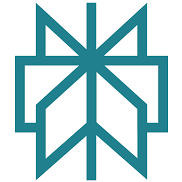Selling shirts online sounds simple in theory, but once you start exploring all the options, things can get overwhelming fast.
Between platforms like Etsy, Amazon, and Shopify, and tools like Printful and Printify, it’s easy to get stuck in analysis mode.
Over the last few years, I’ve tested multiple print-on-demand platforms, marketplaces, and ecommerce tools.
What I’ve found is that the “best” place to sell shirts online really depends on your goals, your budget, and how much control you want over the business.
So in this article, I’m going to break down the most popular platforms and options, how they compare, and which ones I recommend for different scenarios.
Whether you’re just getting started or looking to scale, this should give you a solid roadmap to work from.
Here’s a quick side-by-side comparison of the most popular platforms, based on shirt pricing, fees, and royalties.
| Platform | Setup Cost | Royalties (avg.) | Branding Control | Traffic Provided |
|---|---|---|---|---|
| Etsy | Low | Medium | Low–Medium | Yes |
| Amazon Merch | Free | Low | None | Yes |
| Shopify + Printful | Medium | High | High | No (must drive it) |
| WooCommerce | Low–Medium | High | High | No (must drive it) |
| Redbubble | Free | Low | None | Yes |
| TeePublic | Free | Low–Medium | None | Yes |
| Zazzle | Free | Medium | Low | Yes |
1. Selling Shirts on Marketplaces
Marketplaces are often the easiest way to start selling shirts online. They already have traffic, they’re relatively simple to set up, and most of them integrate with POD platforms.
Here’s a breakdown of the most popular options:
Etsy
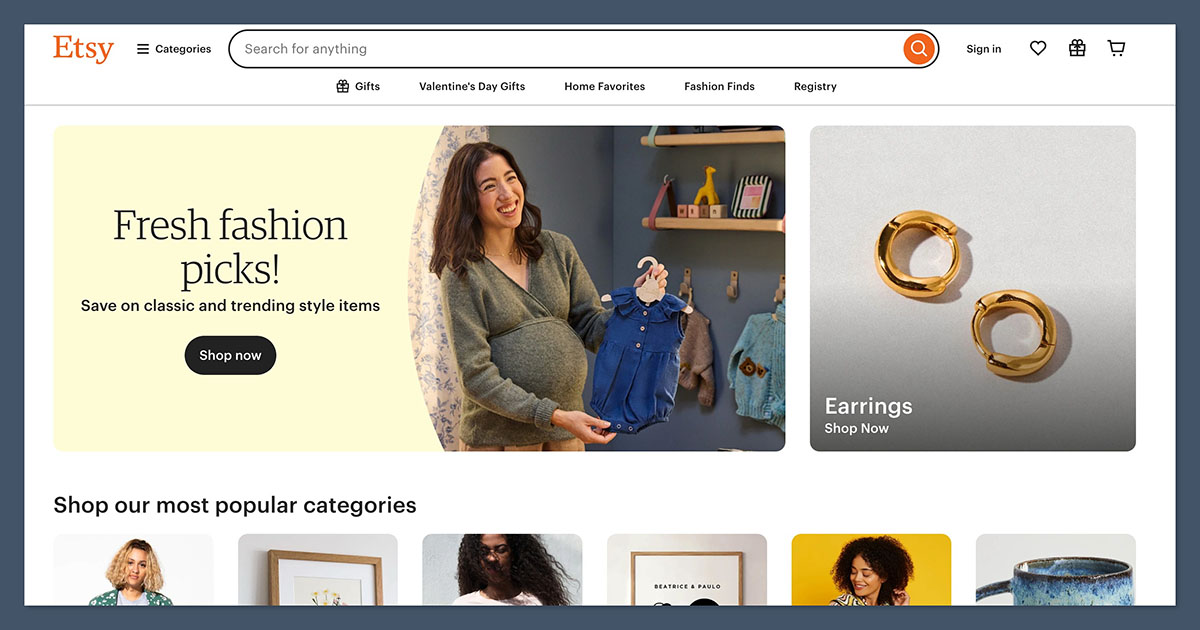
Etsy is one of the best marketplaces for selling print-on-demand shirts.
It attracts shoppers who are looking for unique, personalized, and niche designs.
With tools like Printify or Printful, you can create your shirts and have them shipped automatically without touching any inventory.
Why Etsy works well:
- Built-in traffic of over 90 million buyers
- Strong demand for handmade, artistic, or niche shirt designs
- Supports integrations with POD tools like Printify and Printful
- Great for personalized designs and niche products
What to watch out for:
- Fees can add up (listing fees, transaction fees, payment processing)
- Lots of competition in popular niches
- Limited control over branding and customer experience
Etsy Fee Breakdown:
| Fee Type | Cost |
|---|---|
| Listing Fee | $0.20 per item |
| Transaction Fee | 6.5% of the item price |
| Payment Processing | 3% + $0.25 per transaction (US rates) |
| Optional Ads/Promotions | Varies (Etsy Ads, Offsite Ads, etc.) |
Etsy is a great starting point if you want to test shirt designs without building a full website. Once you find what sells, you can scale to your own store.
Amazon Merch on Demand
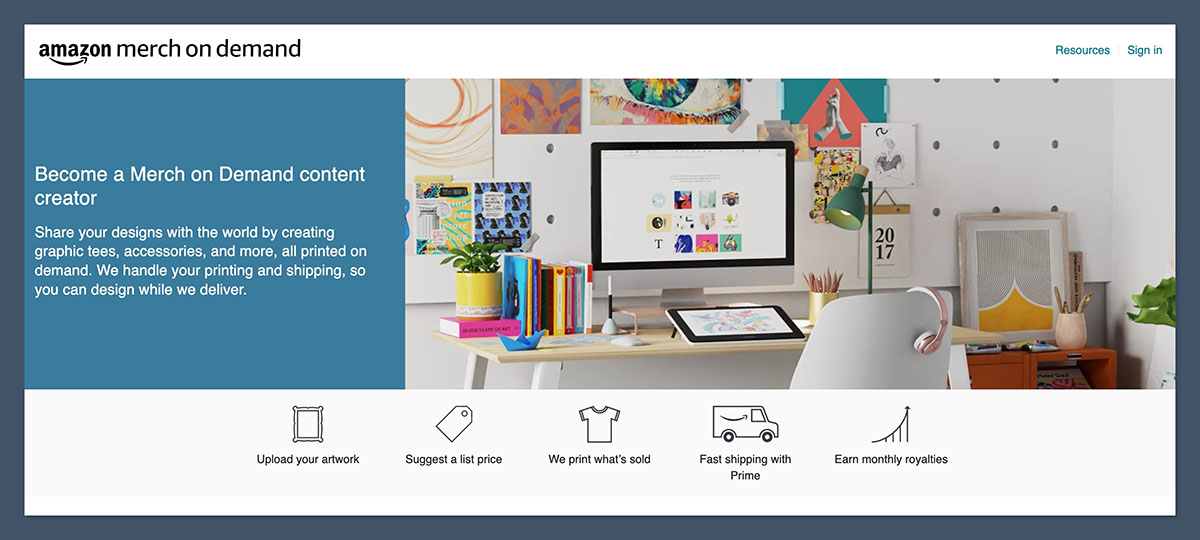
Amazon Merch (also called Merch by Amazon) is a different kind of POD platform.
Instead of integrating with a supplier, you upload your designs, choose a price, and Amazon handles everything — from printing to shipping to customer service.
Pros of Amazon Merch:
- Access to Amazon’s massive audience
- No upfront costs (no listing or subscription fees)
- Totally passive after the design is uploaded
- Amazon handles everything
Cons:
- Approval process can be slow
- Tier system limits how many designs you can upload at first
- Royalty margins are slim unless you price higher
Royalty Structure Example (US Pricing):
| Shirt Price | Your Royalty |
|---|---|
| $15.99 | $2.21 |
| $19.99 | $5.23 |
| $24.99 | $8.45 |
If you already have some design experience or want to earn passive income, Amazon Merch can be a good addition to your POD strategy. Just be prepared for the slow ramp-up.
eBay
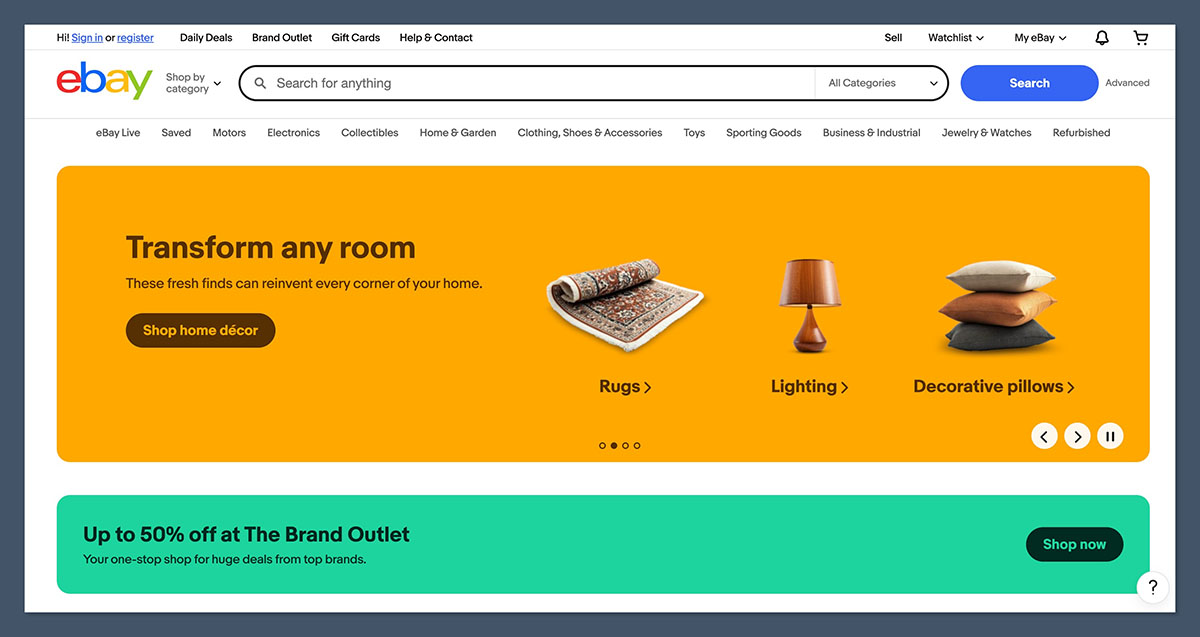
eBay might not be the first place that comes to mind when you think of selling shirts, but it still has a loyal buyer base and decent international reach.
With the right POD app or dropshipping service, it can work well for specific niches.
Highlights:
- Great for novelty shirts, political designs, or trending topics
- Low listing fees and flexible pricing
- International reach and a mature buyer audience
Limitations:
- Doesn’t integrate directly with most POD apps
- Manual order management unless you use a middleware tool
- Less visual and brand-focused than other platforms
I wouldn’t build a long-term shirt business on eBay alone, but it can be a good testing ground or an additional channel if you already have winning designs.
2. Selling Shirts on Your Own Store
If you’re serious about building a brand and owning your customer list, selling through your own store is the best option long-term.
It takes more work upfront, but gives you more control over pricing, branding, marketing, and customer experience.
Shopify + Printful or Printify
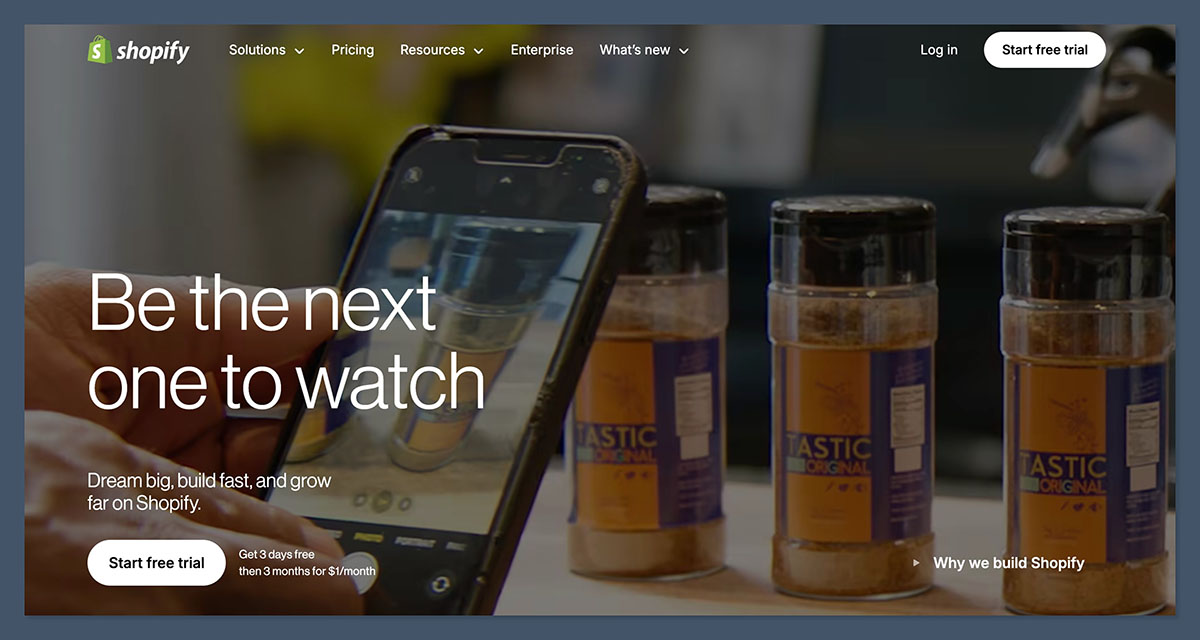
Shopify is one of the easiest ecommerce platforms to get started with. It’s fully hosted, user-friendly, and supports almost every major POD app.
Why Shopify is the top choice:
- Full control over your brand and customer journey
- Seamless integration with Printful, Printify, Gelato, and more
- Built-in support for discount codes, upsells, and abandoned cart recovery
- Scales easily with marketing tools, email campaigns, and analytics
Pricing Overview:
| Plan | Monthly Cost | Features |
|---|---|---|
| Basic Shopify | $39/month | Online store, 2 staff accounts, 24/7 support |
| Shopify | $105/month | Standard plan with better reporting |
| Advanced Shopify | $399/month | Lower transaction fees, advanced analytics |
Why I prefer Printful or Printify with Shopify:
- Printful offers better branding options (custom labels, packaging)
- Printify has cheaper base costs and more print partners
- Both offer wide product catalogs, from basic tees to premium shirts
If you’re starting from scratch and want control over your brand, Shopify + POD is one of the best setups. It gives you the flexibility to grow and scale however you like.
WooCommerce + Printful or Printify
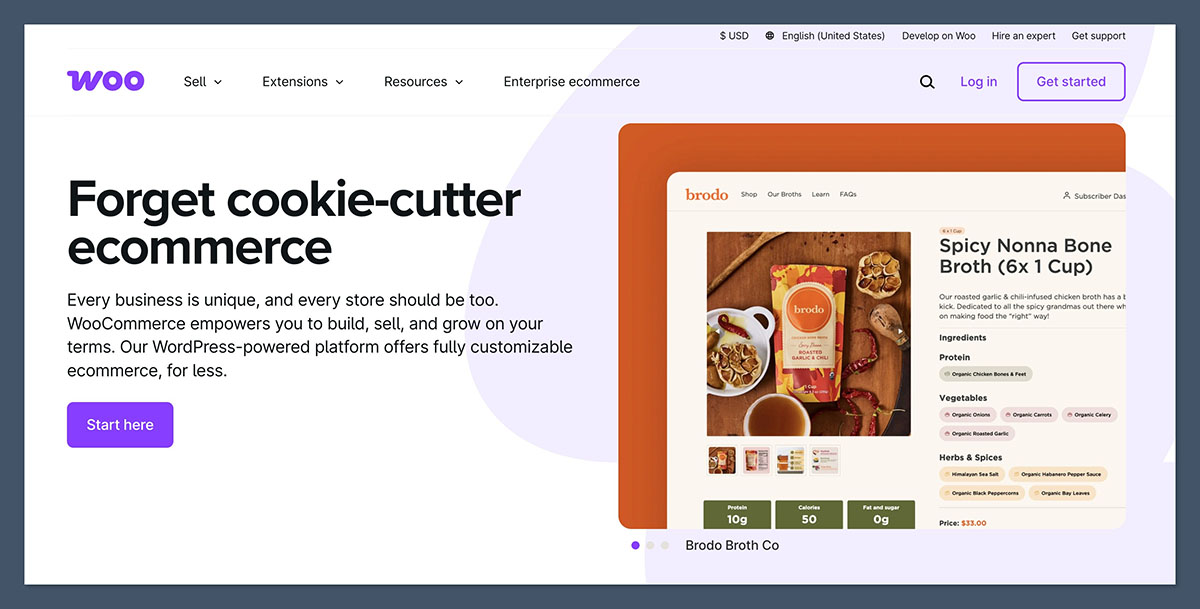
WooCommerce is a free ecommerce plugin for WordPress. If you already have a blog or WordPress site, adding a store with WooCommerce can be a natural next step.
Pros of WooCommerce:
- Free to use (you just pay for hosting and optional plugins)
- Customizable with themes, plugins, and advanced settings
- Integrates with most major POD apps
- Great for SEO if you have blog content already
Cons:
- More technical setup compared to Shopify
- You need to manage hosting, updates, and security
- Some plugins or themes may cause conflicts
Cost Breakdown (Estimated):
| Item | Estimated Monthly Cost |
|---|---|
| Web Hosting | $10–$30 |
| Domain Name | $1–$2 |
| SSL Certificate | Usually free |
| Plugins/Themes | $0–$50 depending |
WooCommerce is a solid option if you’re comfortable managing WordPress. It’s also more cost-effective in the long run if you have traffic from content marketing.
3. POD Platforms With Built-In Marketplaces
Some POD platforms don’t just handle fulfillment — they also give you a storefront and access to their built-in traffic.
These are ideal if you don’t want to build your own site or manage a Shopify subscription.
Redbubble
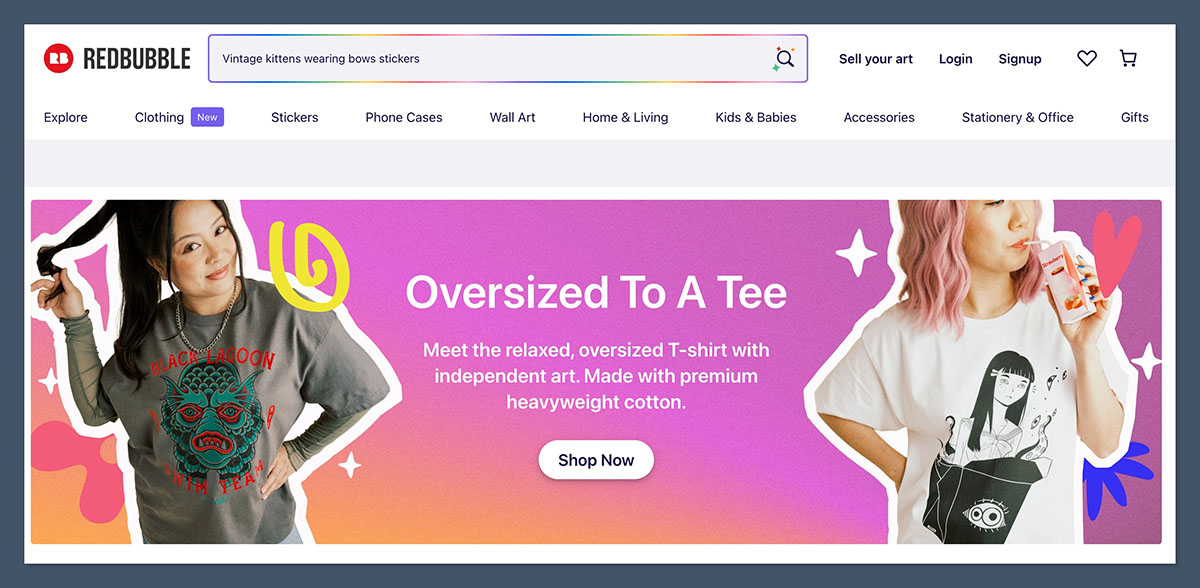
Redbubble is one of the biggest names in the print-on-demand world. It’s completely free to use and has a built-in marketplace that gets millions of visits each month.
Key Benefits:
- Free to create an account and list designs
- No need for customer service or order handling
- Niche art and pop culture-focused audience
Drawbacks:
- Very competitive — tough to stand out
- Limited control over branding or pricing
- Lower profit margins
Typical Seller Earnings (Monthly):
| Seller Type | Average Earnings |
|---|---|
| Hobbyist | $20–$50 |
| Consistent Seller | $100–$300 |
| Top Seller | $1,000+ |
Redbubble is a good passive option. Upload your art, optimize your tags, and let the algorithm do the work.
But don’t expect huge profits unless you have a unique niche or viral designs.
TeePublic
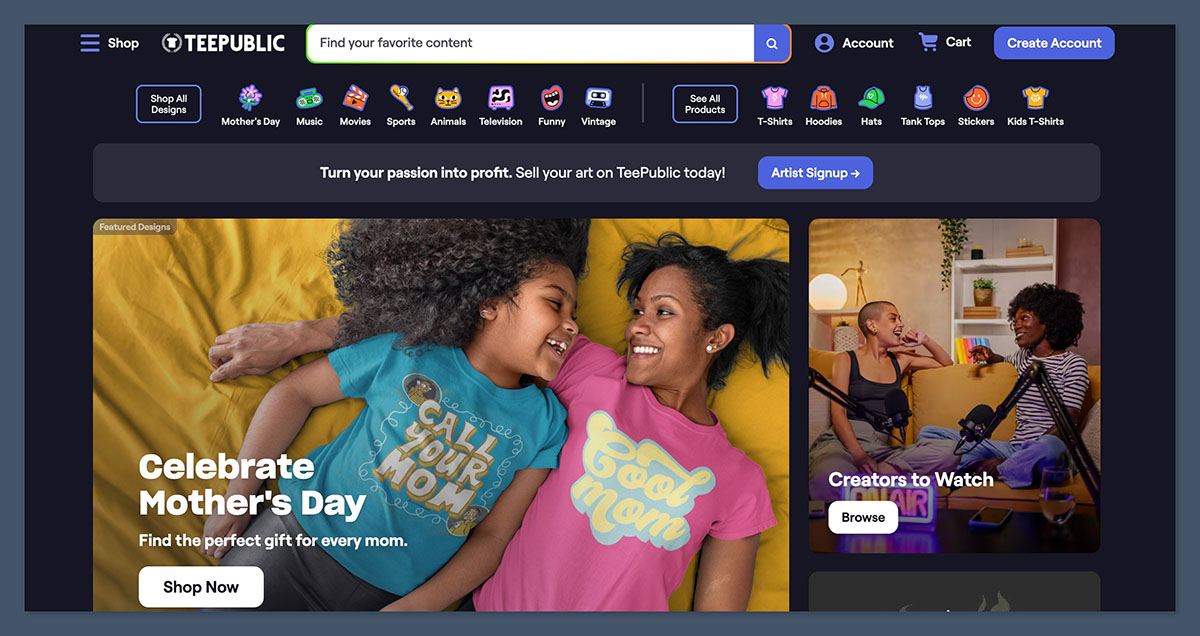
TeePublic is similar to Redbubble, with a strong emphasis on t-shirts. It’s part of the same parent company (Redbubble Inc.) and operates on similar terms.
Strengths:
- Simple, user-friendly platform
- Frequent sitewide promotions help drive sales
- Artist-first approach with decent royalties
Challenges:
- Royalties drop significantly during sales
- No access to customer emails or backend data
- Limited customization options
Royalty Structure:
| Sale Type | Earnings per Shirt |
|---|---|
| Regular | ~$4.00 |
| Discounted | ~$2.00 |
TeePublic works best for designers who want a low-maintenance way to list shirt designs. It’s not a brand-building platform, but it’s reliable for extra revenue.
Zazzle
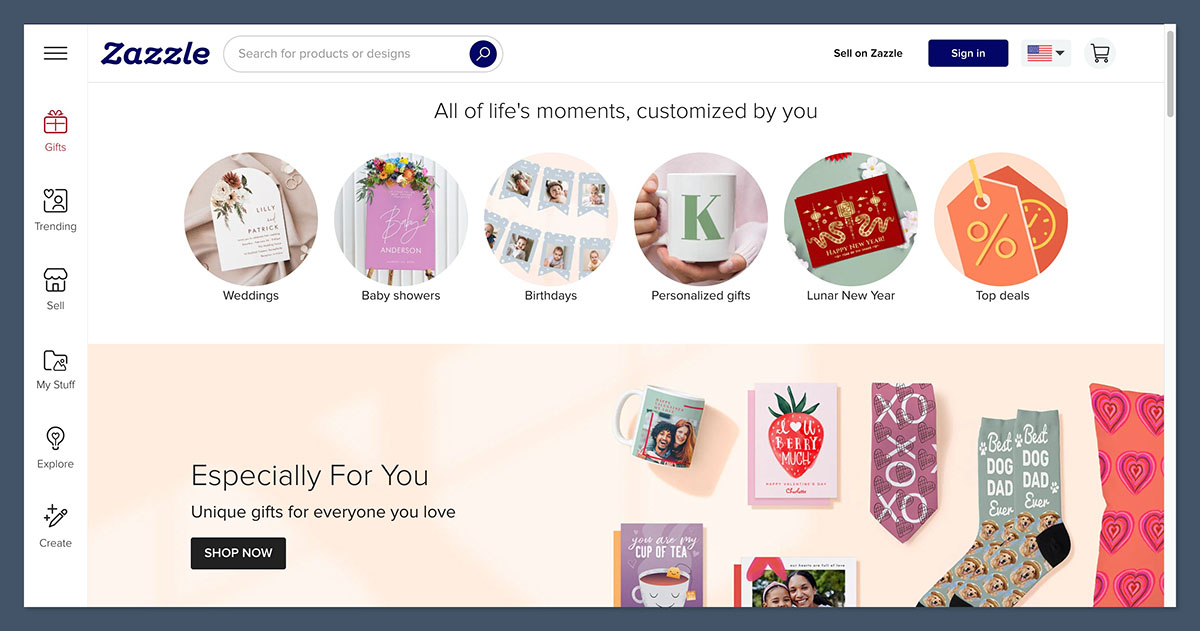
Zazzle offers a massive catalog of customizable products, including t-shirts. The setup is a bit more complex, but the audience is more design-focused and interested in personalization.
Pros:
- Customization options for buyers (text, images, styles)
- Good for artistic and high-detail shirt designs
- Exposure through Zazzle’s marketplace
Cons:
- Royalties can be confusing to calculate
- More time needed to set up products correctly
- Smaller shirt market compared to Redbubble or Etsy
Royalty Structure and Cost Breakdown:
Zazzle gives sellers control over their royalty rate. The minimum is 5%, but most creators set it between 10–15% to stay competitive while still earning a profit.
| Item Type | Base Price (Estimate) | Recommended Sale Price | Seller Royalty @ 10% | Notes |
|---|---|---|---|---|
| Basic T-Shirt | $16.95 | $18.95–$21.95 | $1.89–$2.20 | Depends on brand/style |
| Premium T-Shirt | $22.95 | $24.95–$29.95 | $2.50–$3.00 | Higher-quality fabric |
| Hoodie | $35.95 | $39.95–$45.95 | $3.99–$4.59 | Seasonal best-seller |
| Kids T-Shirt | $14.95 | $16.95–$19.95 | $1.69–$2.00 | Good for niche designs |
Zazzle also charges a small transaction fee (not always transparent upfront), and the final earnings can vary based on discounts or affiliate promotions applied at checkout.
Zazzle is worth testing if you have unique designs that lend themselves to customization. It’s not the first platform I’d start with, but it can work well for certain audiences.
Final Thoughts: Where Should You Start?
If I were starting from scratch today, here’s what I’d do:
- Start with Etsy + Printify
You get access to built-in traffic and can test designs quickly. Setup is easy, and you can validate what sells without building a website. - Add Amazon Merch for passive sales
Once approved, it’s a great way to earn from designs you’ve already created. - Build a Shopify store once you find winners
Once you have products that are selling consistently, move to your own store for better control and profit margins. - Use Redbubble and TeePublic for long-tail, passive sales
Upload and forget. These platforms are perfect for designs that have ongoing demand without much work.
Every seller’s journey is different, but starting small, testing what works, and gradually building out is the safest and smartest path.


